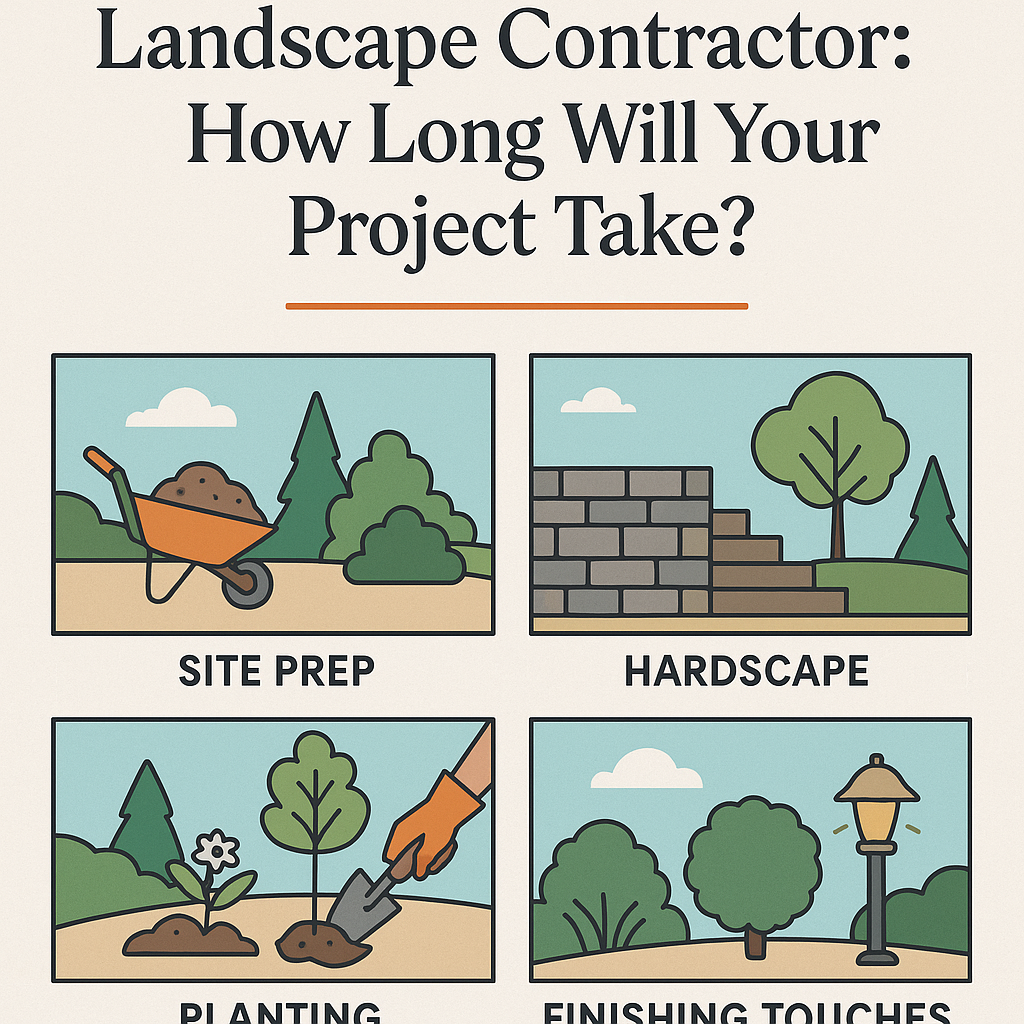When planning an outdoor renovation or new landscape installation, one of the first questions property owners ask is: “How long will the project take?” While timelines vary widely based on project type, scope, weather, and permitting, a skilled landscape contractor helps streamline the process with professional scheduling, clear communication, and proactive project management.
Understanding what affects your timeline—from initial consultation to final planting—can help you set realistic expectations and keep your investment on track.
The Average Timeline for Landscape Projects
A typical residential landscape project can take anywhere from two weeks to several months. Commercial or large-scale civic projects may extend into multiple phases over a year or more. The exact duration depends on factors such as:
- Site preparation requirements
- Size and complexity of the landscape design
- Number and type of hardscape features
- Season and weather conditions
- Material availability
- Contractor crew size and subcontractor coordination
An experienced landscape contractor will create a project timeline that outlines each phase—from demolition and grading to planting and finishing touches—helping you understand where the time goes and how to avoid costly delays.
Pre-Construction Phase (1–4 weeks)
This first phase lays the foundation for everything that follows. It begins with the landscape contractor consultation, which includes a site walk, discussion of goals, and initial feasibility assessment. See what to expect in Landscape Contractor Consultation: What to Expect?.
Key steps include:
- Site measurements and analysis
- Collaboration with a landscape designer or architect (if needed)
- Drafting or reviewing the landscape drawing
- Approvals from HOA, city, or local regulators
- Soil testing and drainage evaluation
- Budget finalization and contract signing
If design revisions or permits are involved, this timeline can stretch. Choosing a contractor who’s experienced in local permitting requirements speeds up this stage significantly.
Demolition and Site Prep (2–10 days)
Once approvals are in place, your landscape contractor mobilizes a team to prepare the site:
- Removing existing structures, sod, or vegetation
- Excavating for hardscape or grading for proper drainage
- Installing rough utilities (electrical, irrigation, plumbing sleeves)
This phase may move quickly on clear, level lots, but more complex properties with tree removal, utility relocation, or severe slope correction may extend prep time.
Hardscape Installation (1–5 weeks)
Hardscape forms the backbone of most landscapes. Features such as patios, retaining walls, pergolas, and outdoor kitchens require foundation work, careful alignment, and often permitting. For a detailed understanding of hardscape vs. softscape timelines, visit Landscape Contractor: Hardscape & Softscape Guide.
Installations that extend the timeline include:
- Multi-tier retaining wall systems
- Outdoor structures with plumbing or electricity
- Custom masonry or poured concrete
- Water features or in-ground pools
- Outdoor lighting systems
Weather conditions can also delay curing of materials or safe access to the site. Contractors often buffer the schedule with extra days to account for this.
Irrigation and Drainage Systems (2–7 days)
Before any planting begins, a landscape contractor installs irrigation and drainage systems:
- Smart controllers and drip zones
- Sprinkler heads positioned for water efficiency
- French drains, dry wells, or bioswales for runoff control
For eco-conscious property owners, contractors integrate water conservation practices from the start. Discover more in How Landscape Contractor Support Eco-Friendly Designs?.
Softscape and Planting (2–10 days)
Softscape installation happens after the hard surfaces are completed. This includes:
- Soil conditioning and compost blending
- Laying sod or synthetic turf
- Planting trees, shrubs, perennials, and ground covers
- Mulching, staking, and irrigation fine-tuning
The number and size of plants, as well as weather conditions, directly impact this timeline. Contractors with experienced crews can install full gardens in days, but complex or tiered planting designs may take longer.
Final Touches and Cleanup (1–3 days)
The final step is finishing. Your landscape contractor will:
- Inspect all plantings and installations
- Adjust irrigation schedules
- Touch up edging, gravel, or lighting
- Clean up the site, remove debris, and perform a final walkthrough
Some contractors also provide a short-term landscape maintenance plan to monitor plant health and irrigation efficiency during the first few weeks post-installation.
Factors That Can Delay a Landscape Project
Despite best efforts, some delays are unavoidable. Common reasons include:
- Poor weather (heavy rain, frost, extreme heat)
- Permit or inspection hold-ups
- Changes to the scope mid-project
- Material or plant availability
- Subcontractor scheduling conflicts
Working with a qualified, well-organized landscape contractor is your best defense against major delays. They’ll create a flexible project calendar, build in buffers, and communicate clearly throughout the process.
How Contractors Keep Projects on Schedule
Experienced contractors use tools and systems to manage timelines efficiently:
- Project management software for crew coordination
- Weekly site meetings with clients
- Regular reporting on progress and next steps
- Established supplier relationships for quick turnarounds
- Skilled subcontractor partnerships (electricians, plumbers, masons)
By combining good planning with real-time communication, your contractor ensures each phase flows smoothly into the next, even on larger or multi-phase installations.
Project Duration by Property Type
While every job is unique, here are some general time estimates based on property type:
- Small residential garden or front yard: 2–3 weeks
- Medium backyard makeover with patio and planting: 4–6 weeks
- Large estate with pool, lighting, and full design-build: 2–3 months
- Commercial property with structural features and green infrastructure: 3–12 months
Contractors may break complex jobs into phases (e.g., hardscape first, planting later) based on seasonality, budget, or access.
Final Thoughts
The duration of your landscaping project depends on many moving parts—but with a qualified landscape contractor, you gain both structure and adaptability. From the first consultation through site preparation, installation, and inspection, their job is to guide the process with efficiency and precision.
By understanding the phases of a typical project and the variables that influence timing, you can make confident decisions, set clear expectations, and enjoy a beautiful, functional outdoor space that lasts for years to come.

